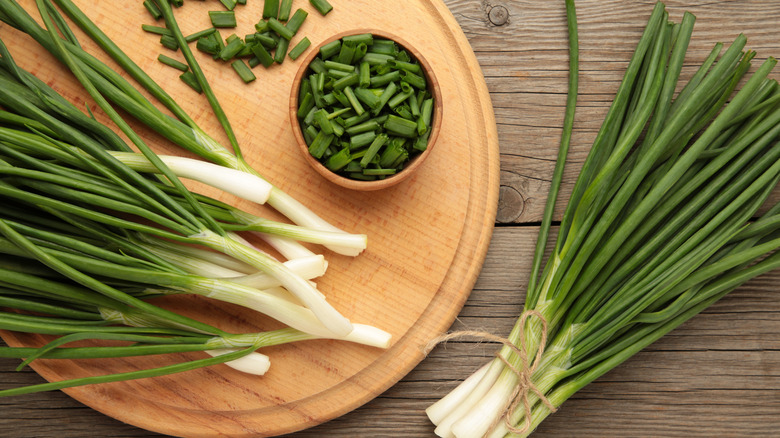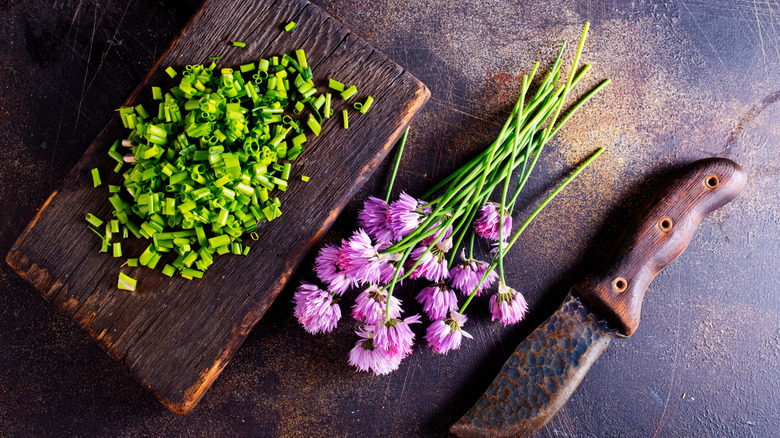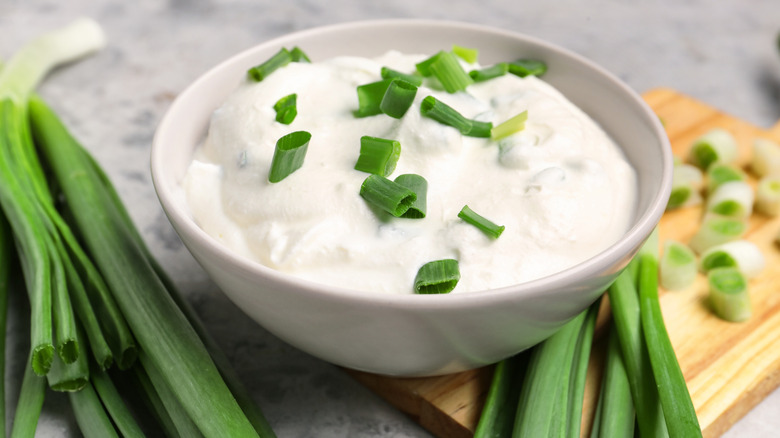How Are Chives Different From Green Onions?
They often show up in different versions of the same recipes. They garnish baked potatoes. They get mixed into cheeseballs. They are sprinkled into soups and salads. They're each tasty ingredients that will change the way you make mashed potatoes. The slender, green, shoot-topped plants known as chives and green onions are often spoken of and used interchangeably. Are they, in fact, the same thing, or is there a difference between them?
There's good reason for the confusion. While these two edible plants are, indeed, related — they both belong to the Allium genus – they are two completely separate entities. Their similar taste profiles and appearances add to the confusion — both have mild onion flavors and both are long, slender, and a grassy green. But the differences between them are distinct enough to remove all doubt as to whether or not they are different food items. It's par for the course on this culinary family tree, though — their allium cousins, onions and shallots, get confused a lot, too.
The delicate chive — what it is, and how it's used
The slender, grassy flowering plant known as the chive is the smallest member belonging to the onion family, and it differs from its relatives in that it's a perennial plant. Between chives and green onions, chives have milder onion flavor, and their green tendrils are also more slender. They are categorized as an herb and are most commonly utilized that way in culinary applications.
Chives can be purchased long and fresh from the produce section of a market or can be found freeze-dried in containers in the spice aisle of the store. In their freeze-dried form, they are used like any herb or seasoning, being dispensed from their shaker containers into dishes as desired. Fresh chives are most commonly utilized raw. If cooked, they should be added near the end of the process, as they are delicate and should only be briefly subjected to heat or they'll lose their flavor. They can also develop a bitter taste when cooked.
While the entire chive plant is edible, it's typically the long, green leaves that are cultivated for use. For a short part of their growing season, chive plants also have purplish blossoms at the top that bud out into floret clusters. These florets have a very delicate onion flavor and can be used as pretty, colorful garnishes for dishes. They are also often used to infuse flavor into vinegar. The biggest hurdle is actually finding chive blossoms – unless you grow your own chives or know someone who does, you can typically only find the blossoms for sale near the end of spring in farmers markets or possibly in stores that carry fresh or organic foods.
The versatile green onion: its classification and uses
Green onions are known by various names — it's no wonder they suffer from a bit of an identity crisis in the food world. Green onions and scallions are the same thing, and they are also known as bunching onions. In Spain, a special variety of green onion, called a calçot, has Protected Geographical Indication status from the European Union and even has its own festival.
Whatever name you may know it by, this savory plant is a vegetable. From its small, white bulb to its long, hollow stalk, the entire green onion is edible. While the whole scallion has onion flavor, the green shoot has a milder taste, while the white bulb end contains the strongest savor.
Green onions can be eaten raw or cooked and lend themselves well to both applications. In raw form, they are commonly cut up as a garnish on salads, mixed into tuna fish, added to soups and dips, and used to top dishes like potato salad, deviled eggs, mashed potatoes, and chili — and there are many more raw uses for this versatile plant. Green onions have many applications in cooking, as well, from incorporation into stir-fries and omelets to being folded into bread doughs and being the star ingredient in casseroles, and beyond. Green onions also feature prominently in Asian cuisine.



